Traditional Braces Cumming
Reliable Orthodontics for Straighter Smiles

At Serenity Orthodontics, Dr. Podray-Donovan, Dr. Pelt, and Dr. Lewis are trusted orthodontists in Cumming who are committed to helping patients achieve straighter, more perfectly aligned smiles. Whether it is overcrowding, spaces between teeth, an overbite, underbite, crossbite, or open bite, they can use traditional braces to realign and straighten teeth and produce show-stopping smiles. Using metal brackets and wires, this tried-and-true method of orthodontic treatment is certain to leave you feeling more confident and comfortable with your newly aligned teeth. If you’re ready to learn more about traditional braces in Cumming, contact us today to schedule an appointment.
Why Choose Serenity Orthodontics for Traditional Braces?
- We Treat Children, Teenagers, and Adults
- Three Female Certified Orthodontists
- Dental Insurance and In-House Financing Available
How Do Traditional Braces Work?
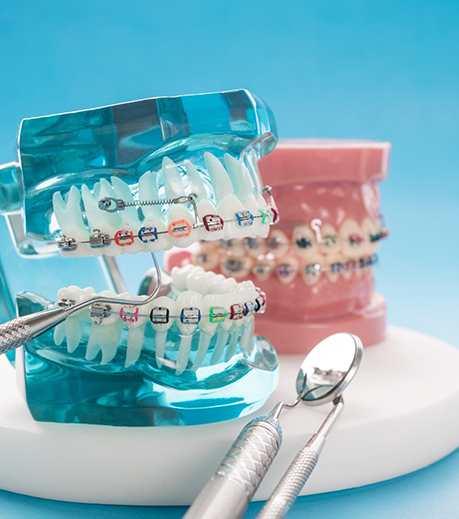
Traditional braces use a metal bracket and wire system to shift teeth in the right direction. When preparing for treatment, your orthodontist will bond each bracket to the surface of your teeth before threading an archwire through the brackets. This will allow both components to work together and apply gentle pressure. Throughout treatment, you will notice your teeth shifting closer to their desired location. However, you will be expected to maintain follow-up appointments with your orthodontist to allow for wire tightening, adjusting, and replacement.
If necessary, our team at Serenity Orthodontics can incorporate elastics, Propel, and other orthodontic appliances to help move the process along more quickly and help you achieve faster results.
Who Is a Good Candidate for Traditional Braces?

One of the great aspects of traditional braces is that they are an optimal solution for children, teens, and adults. Literally, anyone can receive orthodontic treatment using metal braces in Cumming. Yet, it is important that you have good general oral health when starting treatment simply because tooth decay, gum disease, or another serious dental health problem can cause problems along the way.
If you are dealing with overcrowded teeth that cannot be easily cleaned, spaces between your teeth that leave you feeling embarrassed by your aesthetics, or a misaligned bite that is causing chronic jaw pain and other similar symptoms, traditional braces may just be the right solution for you.
What to Expect When Getting Traditional Braces

When preparing to move forward with traditional braces, you’ll first need to schedule a consultation with Dr. Podray-Donovan, Dr. Pelt, or Dr. Lewis. It is during this appointment that they will examine your smile as well as capture digital images and impressions. Using all the information collected, they will create a personalized treatment plan that goes over how your teeth will move over time. Once you are satisfied with the plan, the process of placing your metal braces can begin.
We will bond each bracket to the surface of your teeth, and at each appointment, our qualified team will place a new programmed memory wire. With our traditional braces, the dreaded manual bending and tightening is completely eliminated. Instead, our team places each individual bracket with precision, similar to putting a sticker on a fingernail. This streamlined process ensures a more efficient and comfortable experience, with required follow-up appointments focused on adjusting the wire to guide your smile in the right direction.
It is not uncommon for treatment to take between 1-2 years, but this can vary depending on your individual needs and the severity of your dental problem. Once your braces are removed, it will be necessary for you to wear a retainer. This metal, removable appliance will help to keep your teeth in their new location and prevent them from shifting back into their original position.
You are advised to maintain optimal oral hygiene while wearing braces to prevent tooth decay and gum disease from developing. It is also recommended that you stay away from hard, crunchy, or sticky foods that could damage your oral appliances and cause a delay in your treatment timeline.
Benefits of Traditional Braces
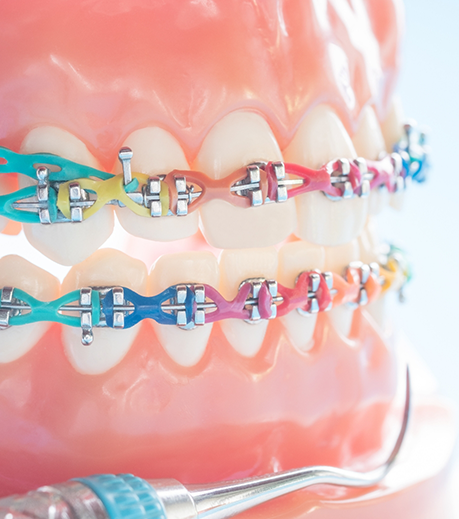
Although there are other types of orthodontic treatments available, the truth is that there is a reason so many orthodontists continue to rely on traditional metal braces for treatment. Not only do they work effectively, but they also provide a host of other great benefits, including:
- Greater versatility in treating both minor and the most complex and severe orthodontic cases.
- They’re customizable so younger patients can make treatment fun and more exciting (i.e., colorful rubber bands and ligatures). Adults can also opt for clear or tooth-colored brackets and wires to make treatment more subtle and discreet.
- They are far more affordable than clear aligners or other similar systems.
- Metal brackets are bonded into place, making it easier to undergo treatment since you don’t need to remember like you would with a clear aligner system.
Understanding the Cost of Traditional Braces
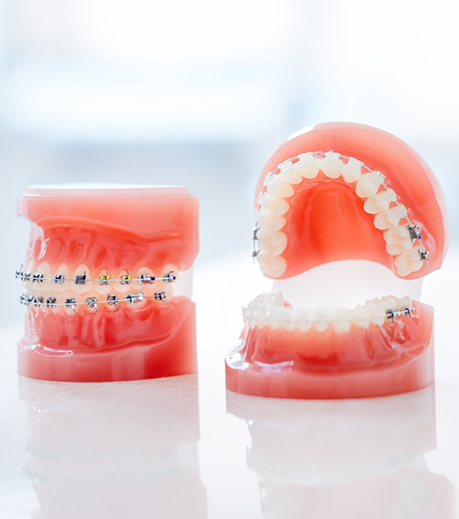
Pinning down the precise cost of dentistry is always a bit tricky without knowing a patient’s exact situation. This is even more so the case when it comes to orthodontics, where the severity of misalignment can vary enormously.
We’ll be happy to give you an estimate of what traditional braces will cost you when we meet at a consultation, but until then, here are some things you may want to know about the price of orthodontics:
Factors That Affect the Cost of Traditional Braces

The cost of traditional braces depends on a few factors:
- The severity and complexity of your dental misalignment. This affects the length of your treatment, the type of accessories you will need, the number of appointments you should attend, and more. Logically, more severe and complex cases incur higher overall fees.
- Your age. Adult cases can be more complex and take longer to correct than those of younger folks, so costs might be slightly higher.
- Your compliance with treatment instructions. If you neglect oral hygiene, fail to wear proper accessories, or make other missteps throughout your treatment, you may end up having to pay slightly more.
Professional Braces vs. “DIY” Braces: Which Costs More?
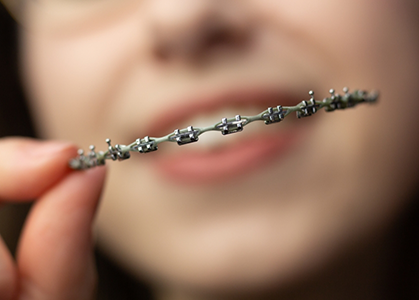
You might have seen so-called hacks on social media that show you how to make your own braces at home. These ideas typically involve the use of things like super glue, rubber bands, paper clips, and other household items.
While you might be tempted to try out such DIY hacks to save money, extreme caution is in order. Without professional training and equipment, you could easily worsen your dental misalignment. Ultimately, you could end up having to pay a professional more to correct the damage done by DIY braces. It would be more economical to visit a qualified orthodontist right from the beginning of your teeth-straightening journey.
Does Dental Insurance Cover Braces?
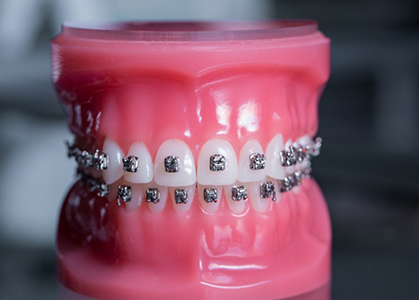
Some dental insurance plans cover braces; others do not. You are more likely to receive coverage if you are a minor, or if you have a premium policy that includes orthodontic coverage for adults.
If your plan covers braces, it may pay for up to 50% of the cost of your care, up to the amount of the plan’s lifetime orthodontic maximum. With the help of their benefits, some patients can reduce their out-of-pocket costs by hundreds or even thousands of dollars.
Our team welcomes insurance, and we are in-network with several popular plans. Ask us how we can help you maximize your benefits!
Options for Making Braces Affordable
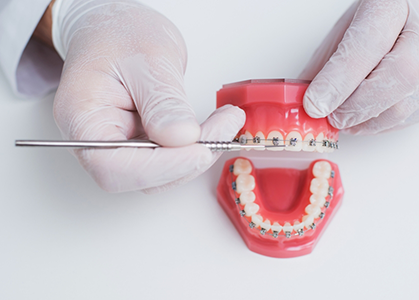
Outside of insurance, other options might make it easier to afford your braces:
- Financing. At Serenity Orthodontics, we are proud to offer interest-free in-house financing. Most patients find that their monthly payment amount fits comfortably into their family’s budget.
- Other options. Braces are often eligible for FSA or HSA funds.
Are you eager to learn more about traditional braces and their cost? Get in touch with our team today to request a consultation!
Traditional Braces FAQs
Why Do My Teeth Feel Loose with Braces?
True enough, it can seem worrying if your teeth feel loose while wearing braces. However, there really isn’t anything to fear; looseness is a sign of effective treatment.
You see, braces work by applying force via their brackets and wires. This process loosens the ligaments holding your teeth, letting it move your pearly whites into place. As a result, it’s common to feel as if your chompers are loose or “floating” during care.
Thankfully, the sensation fades after your braces are removed. At that point, your jaw will start to resolidify the tooth ligaments. The feeling of looseness stops once that solidification is done.
Can Traditional Braces Fix TMJ?
Generally, yes – metal braces can often fix TMJ disorder (or simply ‘TMJ’). Whether they can treat your own, though, will depend on your situation.
Braces could help if your TMJ stems from orthodontic issues. For instance, perhaps your upper and lower jaws aren’t well-aligned. Similarly, maybe you have crooked teeth that exert more pressure on one side of your jaw. In either scenario, braces would align your teeth and jaw and alleviate unpleasant TMJ symptoms.
Can I Chew Gum with Traditional Braces?
Ultimately, you shouldn’t chew gum while wearing braces. Qualified dentists discourage the habit due to how it endangers your treatment.
Remember, chewing gum is inherently sticky; it clings to teeth once in your mouth. As a result, it could easily bend the wires of your braces. Your chompers would then shift in unexpected directions without you even realizing it. Should that happen, you’d face treatment delays or need replacement braces.
Of course, you can go back to chewing gum once your braces are removed. Not only will the treatment risks be gone, but the practice could relieve any lingering post-treatment pain.
Can You Drink Coffee with Traditional Braces?
In most cases, you can drink coffee with traditional braces. You should just be careful when doing so to avoid adverse side effects.
If you don’t already know, coffee is a notorious stain agent. It can discolor teeth and brackets when you ingest too much. Should your teeth get coffee stains during braces treatment, you’d be left with unpleasant splotches afterward.
Fortunately, it’s possible to avoid these stains in the first place. One way is by sipping coffee through a straw. As for another, you can brush your teeth (or rinse your mouth) roughly 20 minutes after finishing a cup.
Do Traditional Braces Hurt?
We won’t lie; you can expect to experience some soreness during your orthodontic treatment. However, this is actually a good sign because it means that your teeth are moving into their ideal positions! Plus, there are several easy ways you can combat this discomfort, from placing a cold compress against the outside of your cheek and putting orthodontic wax over your braces to taking OTC pain medication as directed.
What Can You Not Eat with Traditional Braces?
Mainly, you can’t eat anything particularly crunchy. A few examples include raw nuts, whole apples, popcorn, and tortilla chips. However, patients should also avoid eating corn on the cob, meat on the bone, pizza crust, caramel, and taco shells. Basically, you don’t want to fill your plate with anything that can potentially break a bracket or wire. This may seem inconvenient, but it’s crucial to prevent an orthodontic emergency that can derail your treatment plan!
Am I Too Old to Get Braces?
Good news: candidacy for braces isn’t determined by age alone! In other words, there’s technically no such thing as being “too old” for orthodontic treatment. So, if you’re interested in straightening your teeth, don’t let your age stop you from scheduling a consultation. You may be surprised to hear that adults often end up being some of the best patients since they are investing their own money and understand the importance of good oral hygiene.
What Happens After You Get Your Braces Off?
After we remove your braces, we will provide you with a custom retainer. Although you don’t have to wear it 24/7, it is important to wear it consistently. Remember, upwards of 50% of patients experience orthodontic relapse after their treatment (which is when your teeth move back into their misaligned positions). One of the best ways to preserve the alignment of your teeth and protect your investment is by wearing your retainer as directed.
How Long Do Traditional Braces Take?
Naturally, the length of your orthodontic treatment will depend on numerous factors, including the severity of your misalignment and how well you follow the guidelines we provide. With that being said, it usually takes anywhere from one to three years to completely straighten your teeth. Although it can be tough to wait that long, we must move your teeth gradually. Otherwise, the health and function of your smile could be negatively impacted.
How Do I Take Care of My Braces?
During your orthodontic treatment, you need to take care of your teeth and your braces. This requires a few tweaks to your dental care regimen, including brushing your teeth and cleaning around the brackets after each meal. To make this easier, consider buying some special oral hygiene products, like an interproximal toothbrush and pre-threaded floss, and keep them with you when you go to the office, run errands, or grab lunch with friends.
How Do I Know If I Need Braces?
If your teeth aren’t aligned properly, it’s worth setting aside time to come to our office for a consultation. At this visit, you’ll meet with one of our talented orthodontists who will get to know you before completing an exam. Next, they’ll review their findings with you and share their recommendations on the best way to move forward.
Remember, orthodontic treatment doesn’t just improve the appearance of your smile but also its health and function. In other words, it’s important to learn about your treatment options since crooked, spaced-out, and otherwise misaligned teeth can lead to an increased risk of tooth decay, TMJ dysfunction, and other oral health problems.
What Should I Do If My Wire Is Out of Place?
A wire that’s out of place can be extremely uncomfortable, especially if it’s in a position where it’s irritating the soft tissue in your mouth. If you find yourself in this situation, use a piece of dental wax to cover the sharp edge and give us a call right away so we can set aside time for you to come in. It’s also important that you don’t do anything that could cause the wire to move even further out of place, like eating hard, sticky, or crunchy foods.
How Can I Prevent Mouth Sores with Braces?
Although mouth sores are completely normal, they can be quite uncomfortable. Fortunately, there are a few ways you can help prevent them, like keeping your consumption of added sugar to a minimum and committing to a solid oral hygiene regimen.
Note: If you already have one or two mouth sores, there are also some things you can do to help them heal faster. Try rinsing your mouth with warm saltwater periodically, covering any sharp edges of your braces with dental wax, sipping on cool water, and eating a well-balanced diet filled with lots of nutrient-dense foods.

